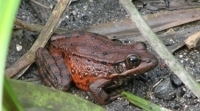Urgent! Sharp Park Hearing at the California Coastal Commission

Thursday, April 16th, 12:30pm-2:00:pm: Your attendance is requested for a critical public meeting in San Rafael (Marin County). That afternoon, the California Coastal Commission will be responding to the City of San Francisco’s request for a permit to dredge and continue draining Sharp Park wetlands. Your voice is needed to inform the Commission why the wetlands should not be dredged and why the City needs to end its ongoing degradation to the wetlands and the wildlife that depend on it. This will be the first and ONLY time an agency with a mission to protect wetlands will review the project!!
Join the members of the Restore Sharp Park Coalition! Please contact jcrofton@wildequity.org for more information or to RSVP. We can answer questions and provide you with talking points, too. Details of the meeting below!
WHAT: Coastal Commission meeting where Sharp Park dredging and wetlands draining will be considered, and either denied or permitted.
WHEN: Thursday April 16th at 12:30pm. The Sharp Park agenda item is likely to come up right after lunch. Please arrive at 12:30pm and join fellow supporters for lunch at the cafeteria within the building.
WHERE: Marin County Board of Supervisor’s meeting room. Marin Civic Center. 3501 Civic Center Drive, Suite 329, San Rafael, CA 94903.
WHY: This is our best opportunity to stop this misguided project. Please lend your voice at this important meeting!


**** Talking Points ****
• The Sharp Park Pumphouse Project proposes to dredge sediment and aquatic vegetation from the Laguna Salada wetland complex so water flows more rapidly to the pumphouse, allowing the pumphouse to drain the wetland complex at a faster rate.
• Experts such as Greg Kamman—the hydrologist retained by SFRPD to analyze Sharp Park’s hydrology—have explained that increasing the pumping rate will harm the threatened California red-legged frog and the Laguna Salada wetland complex in at least two ways:
o Increasing the pumping rate will cause additional harm to the California red-legged frog by draining more of the frog’s breeding habitat before the frog can reproduce.
o Increasing the pumping rate will cause the complex’s water level to remain shallow for a longer period of time. Because aquatic vegetation grows rapidly in shallow water, the project’s purpose cannot be sustained unless the wetland system is dredged regularly. Dredging releases harmful sulfur-based sediments into the water column, and regular releases of these compounds can disrupt the wetland complex’s ecology.
• These experts have proposed a feasible to the pumphouse project: allowing the wetland complex’s water levels to rise higher than the aquatic vegetation can tolerate.* This would reduce the amount of aquatic vegetation in the wetland complex without harming the frog, and would not require regular dredging.
• The Laguna Salada wetland complex and the adjacent Mori Point National Park are one of the most prolific California red-legged frog breeding areas in the state. Yet the California red-legged frog population is declining at Sharp Park because existing pumping protocols cause egg masses to be killed when the wetland system is drained.
• Draining existing or future breeding areas at faster rates will not enhance the California red-legged frog population. To enhance the population pumping rates must be reduced so that eggs can hatch and tadpoles can become adults before the wetlands are drained.

Sharp Park wetland

Leave a Reply
Want to join the discussion?Feel free to contribute!